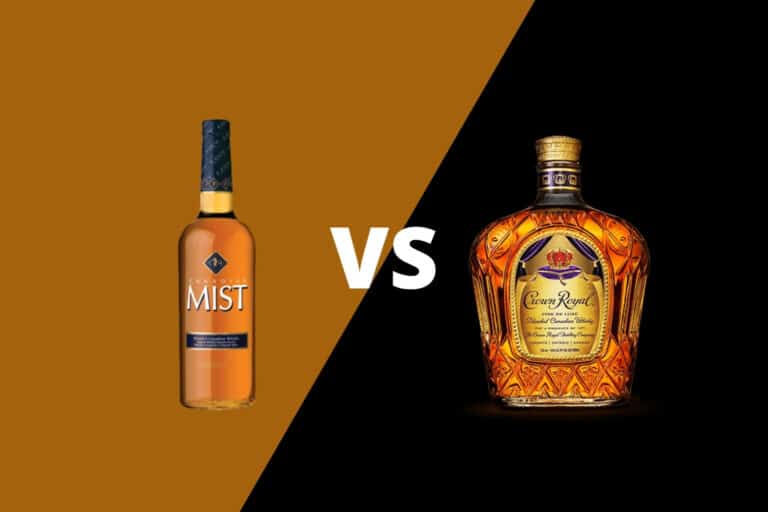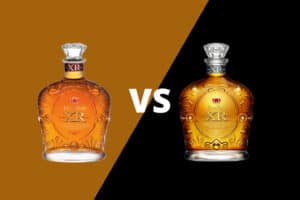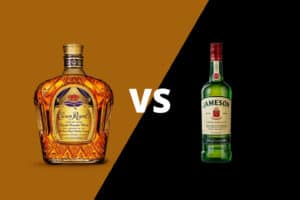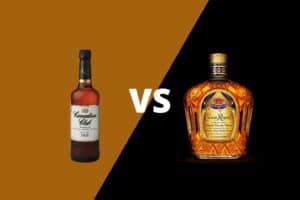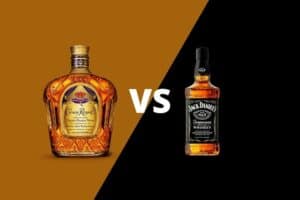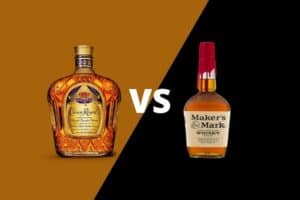Crown Royal is the No. 1 brand of Canadian whisky in global sales, while Canadian Mist is No. 3. And at home, Crown Royal is America’s best-selling Canadian whisky, followed by Black Velvet, Canadian Club and Canadian Mist comes in at No. 4.
It makes sense that those looking to learn more about Canadian whisky might want to know more about these two brands. In this post, we’ll not take a peek behind the label to learn more about how these brands are made, but we’ll discover what makes the Canadian whisky category unique and how it differs from other types of whisky — like bourbon, scotch and Japanese whiskies.
And, we’ll finally give an answer to what you’re asking for when you order a glass of ‘rye.’
Table of Contents
History
The history of whiskey in North America dates back to the earliest European colonial presence. In the 17th century, British and French settlers were among the first to move into the Northeast reaches of the continent. Farmers in the colonies reaped what sustenance they could from the land, and with any excess fermented beverages, they distilled them into shelf-stable spirits.
Scots émigrés would have been well familiar with making whisky from malted barley. But in the cold climate of what is now Ontario and Quebec, heartier grains like rye, wheat and native maize would have been more abundant. Moreover, the comparatively lighter and more neutral spirit distilled from malted barley and other grains was a far cry from the spicy, bold flavor derived from rye. So, locals colloquially called any whiskey with a portion of the spicy grain ‘Rye’ – as in, ‘Pour me another glass of rye!’
Let’s fast forward to 1939 when Canada was preparing for an important visit. King George VI and Queen Elizabeth made the first trip by reigning monarchs to North America. Special occasions call for a special whisky, so Seagram’s president Samual Bronfman raided the warehouses of the company’s many brands — including Seagram’s 7 Crown and Seagram’s V.O. He dumped the best barrels to create a special blend of whisky — which he dubbed the Crown Royal. The royal family was gifted 10 cases in hand-cut crystal containers housed in rich velvet pouches with real gold stitching.
The Canadian Mist Distillery was built in 1967 by Barton Brands, who launched the Canadian Mist Whisky brand but only operated the distillery for about four years before selling the facility and brands to Brown-Forman, the Kentucky-based distilled spirits company best known for producing Jack Daniel’s.
The Barton Brands drinks company was then acquired by Constellation brands in 1993 and sold to Sazerac in 2009. In August 2020, Sazerac completed a separate acquisition of the Early Times, Canadian Mist and Collingwood whiskey brands along with the Canadian Mist Distillery in Collingwood, Ontario, Canada, on the shores of Lake Huron from Brown-Foreman.
Mashbills
When looking at the Canadian whisky category, keep an eye out for the term ‘Rye’ on the label.
The United States and Canada agreed to honor each other’s regulations regarding distillation and labeling as part of the North American Free Trade Agreement. But each has a different interpretation of the term.
Canadian distillers can use the term ‘Rye’ to describe any whiskey that has any portion of rye grain in the mash bill. But in the United States, a ‘Rye Whiskey’ must contain at least 51 percent rye grain. So a product that contains five percent rye, for example, could be called ‘Rye’ if made in Canada and exported with that terminology on the label to the United States. But a product made south of the border couldn’t contain the term ‘Rye’ in the product’s category description unless it was made with at least 51 percent rye grain.
This is a bit confusing, but it’s an important concept to keep in mind when perusing the aisles of liquor stores or chatting with a group of whiskey nerds.
Both Canadian Mist and Crown Royal are made using various proportions of corn, rye and malted barley. However, unlike whiskeys from the United States like bourbon and rye, Canadian whiskey does not have any mash restrictions other than being made from a combination of cereal grains. And as blended whiskies, producers can mix and mash barrels with various mash bills and distillations techniques to develop the final products.
Both the Crown Royal and Canadian Mist distilleries will produce multiple grain whiskies and flavoring whiskeys to combine in the final blend. The grain whiskies are often distilled to a higher proof from corn and wheat, making them more neutral, light and delicate. The flavoring whiskies will have been produced using higher proportions of rye and malted barley to give the blending team a palate of strong flavors to work with — spicy pepper, herbal and floral notes.
On its website, Canadian Mist boasts that its corn comes from within a 100 mile radius of the distillery, the rye is grown in Ontario, and the malted barley comes from Alberta. Crown Royal uses five different mash bill recipes, 12 column stills and various types of wooden casks to produce about 50 individual whiskies to use as components in the blend.
Crown Royal utilizes five different mash bill recipes to produce the various whiskies used in the final blend.
Neither brand discloses the specific mash bills for the grain or flavoring whiskies that make up the blend.
Distillation & Production
On its website, Canadian Mist describes its whisky as ‘triple distilled.’ The extractive distillation is similar to the type of ‘triple distillation’ that takes place at the Middleton Distillery in Ireland, where Jameson is produced. Three column stills are used — a beer column, an extractive distillation column and a rectifying column — to produce the grain whiskeys used in the final blend.
Jameson, however, utilizes a portion of single pot whiskey produced with malted and unmalted barley and produced on a traditional copper pot still. The Canadian Mist facility in Collingwood does not have a functional copper pot still — a crucial difference between the two. Rather, most ‘flavouring whisky’ used to produce Canadian Mist are produced from rye and/or corn. However, both are neutral and mellow and would hold up relatively well as a shot call at a bar.
Crown Royal has 12 different column stills at its facility in Manitoba. Although some of the 50 different component whiskeys may use a similar triple distillation technique, it would be impossible to know more without speaking to a member of the production staff.
Both brands can boast glacial water sources — Canadian Mist from the Georgian Bay of Lake Huron and Crown Royal from Lake Winnipeg.
Maturation
Unlike styles of American whiskey like bourbon and rye produced in the United States, Canadian whiskies do not have to be matured in new American oak barrels. As a result, Canadian producers queue up with the rest of the whiskey-making world — e.g., Scotland, Ireland, Japan, etc. — to purchase once-used bourbon barrels on the secondary market to age their whiskey.
Here, the flavoring and grain whiskies will differ as well. The flavoring whiskeys will be housed in newer barrels or barrels made from woods other than white oak to give them more complexity and depth, while the grain whiskies will be aged in older, more neutral barrels. Again, a wide variety of barrels may be used — toasted, charred, finishing barrels that previously held sherry or other wines, barrels made of maple wood or cedar.
Canadian Mist utilizes climate-controlled warehouses. It is matured for the minimum required three years in wood barrels. While Brown-Forman owned the company, barrels were sourced from that producer’s Louisville cooperage, with used barrels likely coming from former stable-mate Jack Daniel’s. Now that Sazerac is the owner, the barrel acquisition process might have changed somewhat for the brand. Perhaps used Buffalo Trace barrels are making their way into those climate-controlled warehouses up on Georgian Bay.
As the largest producer in Canada and one of the largest in North America, Crown Royal has 1.5 million barrels resting in the 51 barrel warehouses on its Lake Manitoba campus. From this large stockpile, it will choose various component whiskies to produce the final blend. While many of these barrels may be much older than the minimum three years, Crown Royal does not have an age statement, so the age of the finished product is unknown.
Ownership, Price & Value
New Orleans-based Sazerac acquired Canadian Mist in 2020.
A 750mL bottle of Canadian Mist at 80-proof will cost about $12.
Today, Crown Royal is produced by Diageo PLC – the London-based distilled spirits giant that is the largest whisky producer in the world.
Crown Royal will set you back about $29 for a 750mL bottle at 80-proof.
Tasting Notes:
Canadian Mist Blended Canadian Whisky
Description: Legs are slight at 80-proof. The color of burnished copper with medium hue.
Nose: A bit of pepper, with a bit of vanilla and an herbal grassy note.
Palate: Soft and mellow, with a hint of banana and a nutty cashew character.
Finish: A touch of smoke, with notes of white vanilla, baking spices, cinnamon.
Crown Royal Blended Canadian Whisky
Description: In the glass, Crown Royal has surprisingly healthy legs at 80-proof. It has the color of antique gold.
Nose: Aromas of toasted oak, cherry, rose petal, baking spices – allspice.
Tongue: Delicate mouthfeel, with flavors of almond, cherry, honey, toffee, baking spices – clove and vanilla.
Finish: Light and mellow, with vanilla, toffee, chocolate and orange peel.
[Related: Complete Crown Royal Review]
Verdict…
For its price, Canadian Mist is a soft and smooth whisky with a nice balance that can be enjoyed in cocktails like the whisky sour. It is the ultimate budget-friendly whisky, housed in a plastic 1.75L bottle that is rumored to be great for sneaking into a college football game – not that we would know from personal experience…
Crown Royal is a smooth whisky that is not lacking in flavor. It can also be enjoyed in cocktails but holds up neat or on the rocks.
In a side-by-side comparison, Crown Royal would win hands-down. But as members of wildly different pricing tiers — Canadian Mist in the value segment and Crown Royal a premium brand — these whiskies were never meant to line up side-by-side. Rather, Canadian Mist is a perfect whisky for bar managers looking to increase margins with a neutral whisky that is perfect as a Canadian ‘rail’ or bottom-shelf whisky. On the other hand, Crown Royal is an internationally adored darling whose brand following is the envy of brand managers the world over.

